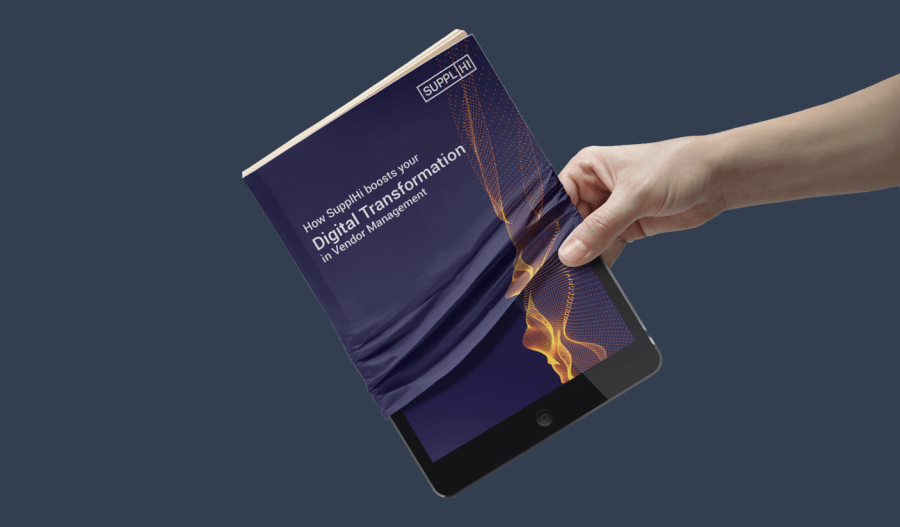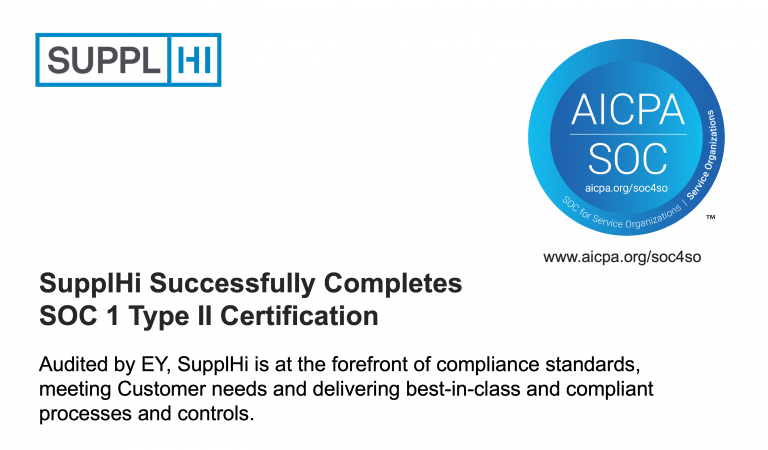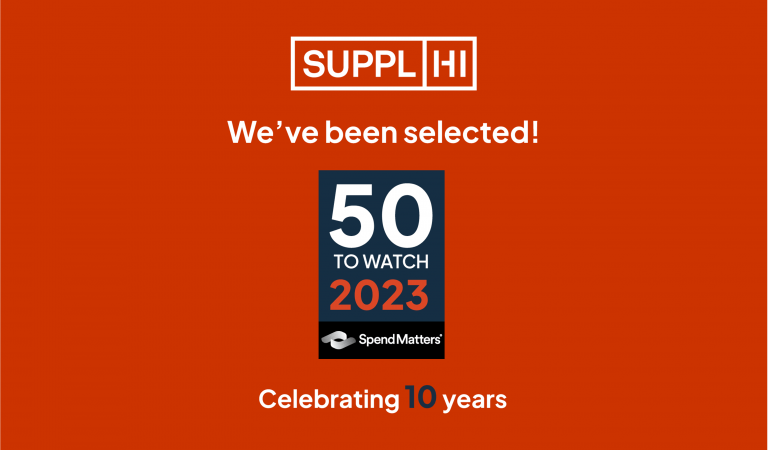Milan – December 10th 2019
Download the full paper at the following link: Download
Organizations in the Plant Engineering industries (Oil & Gas, Chemicals, Power, Renewables, Shipbuilding, Steel & Metals, Cement, …) have been digitizing for decades. Nowadays, the digital transformation is just beginning and will shape the future of our industries to drive productivity increase and to create new business models.
If you think about all the portals for individual vendor registrations that have been created in the past years, Vendor Management could be considered as an early adopter of the “digital” wave. However, individual tools in Vendor Management have supported the formalization of internal custom processes at a cost: a strong increase to the internal hours of senior resources dedicated to Vendor Management, with limited ability to anticipate the raising business needs.
SupplHi’s SaaS (Software as a Service) – born in 2015 and rapidly growing – goes beyond any traditional approach, delivering productivity to Vendor Management activities through a digital service rather than just a software. Learn how SupplHi provides a unique boost to the Digital Transformation of players of all sizes, increasing productivity, reducing up to 80% of Vendor Management costs, mitigating risks and creating new opportunities to procure supplies at lower prices and higher quality. SupplHi is flexible: can be deployed stand-alone and it fits – when present – with existing Vendor Management system linked to any ERP or P2P system through easy API integration.
THE CHASE FOR PRODUCTIVITY THROUGH DIGITAL
Organizations in the Plant Engineering industries (Oil & Gas, Chemicals, Power, Renewables, Shipbuilding, Steel & Metals, Cement, …) are not new to digitalization: from CAD design to BIM, to vendor management portals, the industries had in ICT a strong arm with plenty of investments. Differently from other industries such as Automotive – this has not always reflected into increases of productivity in Plant Engineering where the output per hour work has been basically flat in the last decades. Furthermore, the evolution of ICT in Plant Engineering industries created a complex IT landscape with monolithic giant systems (typically the ERP and the CAD) as well as complex interfaces among modules and other applications.
Digital Transformation is a game-changer because it drives productivity increase through operational efficiency and excellence as well as it creates new business models for both users and providers. In fact, Digital Transformation is the process of using digital technologies to create new – or modify existing – business processes, culture, and customer experiences to meet changing business and market requirements.
A new approach and culture on digital is gradually taking shape in Plant Engineering industries. After the initial euphoria of the 2015-2018 period characterized by several trials & errors, the approach is now becoming more and more oriented towards tangible benefits, returns on investments on digital initiatives within 12 to 24 months from the launch, and to focus on entrepreneurship and change management. This implies the openness to adopt tools that revise and better support traditional processes where users are looking for the simplicity of the B2C digital experience (intuitive steps, mobile access, landing pages, dashboards, …) coupled with the complexity of the processes in industrial B2B.
In order to manage all the potential initiatives, the so-called “Digital Transformation programs” are increasingly frequent – at all levels of the supply chain (End-Users, Contractors and OEMs), with about 80% of Contractors currently undertaking them. They are a unique opportunity to empower and speed up decision making within complex organization, maximise productivity through improved processes’ efficiency to assure the delivery of projects on time and within costs.
Digital Transformation programs typically have a very large spectrum that ranges from Augmented Reality (AR) to Artificial Intelligence (AI), Internet of Things (IoT), automation, machine learning, predictive analytics to digital twin but also involve company-wide processes like Vendor Management.

VENDOR MANAGEMENT AS A VALUE-ADDED FUNCTION
Vendor Management is the set of processes required to manage the relationships between a Buyer organization and its Vendor and Sub-Vendors and it is an enabler for contracting the best Vendor of equipment and services for a specific purpose. Vendor Management is not to be confused with the Procure-to-Pay (P2P) cycle that comes afterward.
Supply Chain requires constant interactions between organizations and this interface is becoming more and more digital to better plan, source and execute the procurement cycle. Therefore Vendor Management is becoming even more important and increasingly digital.
In synthesis, Vendor Management not only represents the start of the digital interaction among companies, but also the single repository for a Buyer organization of all the experiences on Qualification, Performance Evaluation and improvement actions.
Vendor Management activities and functions are now moving from a traditional compliance-driven logic – “I must perform them to satisfy my Quality process” – to a real value-added function to the organization. Several business needs are raising and pointing into the direction of a stronger Vendor Management, with involvement since early commercial phases.

Supply Chain in industrial B2B:
- represents up to 80% of an organization’s revenues
- is truly global as as well as local
- is mainly characterized by SMEs and very long chains
- has peculiarities by category of supply.
Supply Chain functions drive productivity of a company by:
- Buying for less, at higher quality
- Buying faster
- Avoiding sub-performing Vendors or Vendors not adequate for the Buyer organization
COSTS ASSOCIATED TO TRADITIONAL VENDOR MANAGEMENT
Typical Vendor management activities are associated with relatively high costs. It is the combined cost of IT systems, data providers (for Financials and Compliance information on Vendors) and Vendor Management function’s resources – but what really drives on average 78% of the cost of Vendor Management is the time of senior resources involved in Vendor Qualification and Performance Evaluation processes. Once more, it is a matter of productivity of what are typically senior and premium resources that can have internal costs of up to 120 € / hour.
Only an innovative digital solution can strongly reduce the time spent by senior resources involved in Vendor Qualification and Performance Evaluation and in sharing costs and benefits across a network.

“In a world full of technical standards, Vendor Management activities were characterized by the presence of many best practices but an overall lack of an industry-specific standard.”
BENEFITS OF AN INDUSTRY-SHARED APPROACH
Traditional approaches in Vendor Management are based on an individual IT platform. Such traditional solutions typically require months of internal and external resources in order to define the individual Vendor Management model before long and costly implementation on systems.
The involvement of external consultants and the dedication of internal resources is always a great asset for an organization. However better deployed on Change Management rather than on the design of an individual Vendor Management model – especially when this tool does not represent the “core” business of a Buyer organization and a standard and industry-specific model is already available and based on the best international practices. In fact, Change Management and re-skilling of resources is required to support the real adoption of any digital tool and it is where all organizations will focus the most in the next years to support their Digital Transformation programs.
As illustrated in the table below, an individual versus an industry-shared approach provides completely different results on all dimensions: the model is not only already based on the best international practices but also plug & play and efficient in terms of processes generated.
Moreover, the presence of an industry-shared and common standard model for Vendor Management enables a network effect on selected Vendor Management activities. The network provides benefits to all participants – among others:
- the quality assurance of the information provided by Vendors can be performed only once for all Buyer organizations with benefits for both Buyers and Vendors;
- reduced IT development as well as maintenance costs because spread across multiple participants, including the cyber-security costs and the continuous re-factoring of the technology;
- more information made accessible to users for a better and more informed decision making.


SUPPLHI BOOSTS YOUR DIGITAL PROGRAM
SupplHi’s SaaS (Software as a Service) provides a unique boost to the Digital Transformation of players of all sizes, reducing up to 80% of Vendor Management costs, mitigating risks and increasing opportunities in order to procure for lower money and with higher quality of the supplies. SupplHi is not just a software for Vendor Management, but rather a unique combination of five elements delivered through a SaaS approach to meet Clients’ needs and create value for the industry:
-
SupplHi industry-specific standard model
SupplHi platform is based on an industry-specific standard model originated from the continuous analysis of the best international practices and by answering to the most demanding needs of our Clients in Vendor Management. The model is based on the 100+ international best practices to avoid “re-inventing the wheel” and to ensure compliance in processes at industry requirements. Nevertheless, Buyer organizations – during setup and at any time – can adopt on SupplHi their own customization on: Categorization of equipment and services; Vendor Questionnaires; Performance Evaluation processes.
-
SupplHi unique digital infrastructure
SupplHi provides a robust and scalable digital infrastructure that allows users to store and share info in a secure way, based on constantly updated technologies and with strong focus on cyber security. SupplHi platform is 100% on cloud. The hosting is based on Amazon Web Service (AWS), this means access anytime, from anywhere, without the need to download or install any software, and no long waits for new features. SupplHi does not require individual costly development and it is easily accessible by all colleagues in client’s organization. System Integration with Buyer’s ERP Vendor Management and CAD design systems is done by contacting the API Gateway by SupplHi.
-
SupplHi complete solution for Vendor Management
In a single solution, SupplHi covers all aspects of the core of Vendor Management: from Vendor Scouting to Vendor Qualification, Vendor Performance Evaluation and assessment of
Vendor Financials, Compliance and Sustainability. Furthermore, it includes additional modules that act as productivity tools for Clients (e.g. Vendor Lists management, Vendor Campaigns, RFIs, …). SupplHi for Buyer organizations is composed of 10 modules and Clients can select the most interesting modules for their needs and expand to adjacent functionalities at any time. -
SupplHi service deliver
SupplHi – as an independent organization – manages the IT infrastructure of the platform and provides constant quality assurance and update to the information made available by multiple sources (e.g. information from Vendors, financial data, compliance data, …). SupplHi is ISO/IEC 27001:2013 certified by Bureau Veritas for Information Security Management Systems.
-
SupplHi network effect
SupplHi supports Buyers on all the levels of the industrial supply chain (End-Users, contractors, packagers, components and service providers – including both large companies and SMEs) leveraging on the network of Buyers and Vendors that continue fostering the network effects, with benefits in terms of information’s depth and constant update. Furthermore, SupplHi’s network of international Partners supports operations in more than 100 geographies and ensures Global coverage.

- Vendor Scouting: access to Vendors’ basic information that are immediately available on the SupplHi platform across the geographies and categories of supply of interest.
- Vendor Information assurance: access to information provided free-of-charge by Vendors on SupplHi, made visible after the constant quality assurance and expedite by SupplHi.
- Vendor Qualification management: manage and track your Qualification evaluation and approval processes for a Vendor in specific category(ies) of supply and production location(s).
- Vendor Assessment Visits: plan, generate and share with the industry reports of qualification assessment visits at Vendor’s production locations based on the standard model.
- Vendor Lists management: create, follow and share any type of List of Vendors – e.g. Master Vendor List, Project Vendor Lists – performing quick matching among them.
- Vendor Performance Evaluation – Individual use: manage evaluation processes through effective surveys evaluated and approved by colleagues during the lifecycle of the supplies.
- Vendor Performance Evaluation – Industry-shared: access to evaluations aggregated across multiple Buyers and shared to Vendors in order to drive improvements.
- Vendor Financials and Compliance: evaluate the Financials and Compliance strength – including ratings – on Vendors and Sub-Vendors, integrated in a single system.
- Supply Chain Sustainability: monitor the Sustainability performances of your Vendors and Sub-Vendors – covering all ESG aspects (Environment, Social and Governance).
- Vendor Campaigns and RFIs: launch and manage campaigns to a highly targeted audience of Vendors to request clarifications.

HOW TO ADOPT SUPPLHI
SupplHi’s utilization for Buyers is based on the access to the cloud system (“Software as a service – SaaS” contract) to an unlimited number of users of the Buyer organization through an initial one-off setup phase and with annual/multi-annual utilization.
The starting point of every Buyer organization is different and SupplHi is extremely flexible:
- Replacing an existing Vendor Management tools;
- Using specific modules of SupplHi (e.g. Vendor Qualification management or Vendor Performance Evaluation only) in parallel with existing Vendor Management tools. In fact, SupplHi can fit – when present – with any existing Vendor Management model and system;
- Adopting for the 1st time a full Vendor Management tool (e.g. moving from paper-based vendor questionnaires to a structured digital system).
SupplHi is modular. Buyer organizations can take out the most out of SupplHi based on their specific needs: selecting just a module (e.g. Vendor Scouting only) and expanding it to the adjacent functionalities at any time, as well as selecting since the beginning the full sets of modules.
SupplHi is customizable. Buyer organizations avoid complex IT development on their own, just need to focus on setup and system integration. In fact, a series of setup activities on the platform are required to make the system better able to satisfy the Client’s needs. Buyer organizations – during setup and at any time during the utilization of the platform – can request and adopt on SupplHi their own model, based on – among others: their own categorization of equipment and services; their custom templates for Vendor Qualification (including Vendor Questionnaires); their Vendor Performance Evaluation templates.
SupplHi is easy to integrate. In fact, in any case of adoption – either deployed stand-alone or in parallel with other Vendor Management tools – SupplHi can be easily integrated through API with any ERP or P2P system.
The flexibility to integrate an existing system. Individual systems for Vendor Management – when present – have typically created new operational costs (quality assurance of information provided by Vendors, evaluations and approvals by senior resources, assessment visits) and have slowed down the ability to satisfy businesses fast-track needs. In addition, they reach the traditional Vendors of a Buyer organization. In case of adoption of SupplHi to be integrated to an existing Vendor Management system, SupplHi scales-up the existing Vendor Management model by:
- providing full reach to market information on Vendors, also stimulating cross-fertilization among industries and more unbiased views to challenge internal decisions;
- reducing operational costs on quality assurance of information from Vendors and time required by seniors;
- increasing the speed to serve the business;
- allowing to adopt – when possible – standard practices yet maintaining the flexibility to meet customizations;
- allowing to better influence growth of the supply chain.

Utilization for Buyers is based on the access to the SupplHi cloud platform (“Software as a Service” SaaS contract) to an unlimited number of users of the Buyer organization through:
- an initial quick setup;
- an annual or multi-annual utilization.
Customers can select the most interesting modules for their needs and expand to adjacent functionalities, with possibility of easy system integration with the ERP, through API, at any time.
SupplHi manages the IT infrastructure of the platform and provides constant quality assurance and expedite for update to the information on Vendors made available to the network and sourced from the Questionnaires filled by Vendors invited by Buyers and from the financial and compliance data providers.
Decisions on Vendor’s Qualification and vendor’s utilization stay within the Buyer organization.

SupplHi’s system integration with ERP is a traditional step, especially for larger Buyer organizations. SupplHi offers several REST APIs to integrate SuppHi platform with the systems used by its Customers. The list of the eight main APIs is provided below:
- GetVendorData allows to retrieve all Vendor companies present on SupplHi platform and relative data.
- UpdateVendorData allows to update information of Single or Multiple Company on SupplHi platform;
- GetVendorDataHistory allows to get historical information about Single or Multiple published field of a Company on SupplHi platform.
- ImportPurchaseOrders allows to create or update a list of Purchase Orders in the SupplHi platform.
- ImportProjectName allows to create or update a list of Projects in the SupplHi platform.
- ImportExperienceEvidences allows to import on SupplHi some experience evidences related to Purchase Orders on which performance evaluation processes of a Vendor will be executed.
- GetVendorPerformanceData allows to get the results of a performance evaluation processes made on SupplHi platform, about Single or Multiple Company.
- LockVendor allows to temporarily lock status of a Vendor regardless of its completion percentage of Vendor Registration and Vendor Questionnaire.
Furthermore, regarding the Single sign-on (SSO) – SupplHi supports integration of the Client’s IDP through the most popular protocols (SAML 2.0 and oAuth 2.0) and can be configured as an Azure Enterprise Application for native integration with Azure Active Directory. Thanks to SCIM 2.0 support, SupplHi also supports automatic provisioning and deprovisioning from Azure AD or other IDPs that support this protocol.
Download the full paper at the following link: Download



